DODGE TRUCK 1993 Service Repair Manual
Manufacturer: DODGE, Model Year: 1993, Model line: TRUCK, Model: DODGE TRUCK 1993Pages: 1502, PDF Size: 80.97 MB
Page 881 of 1502
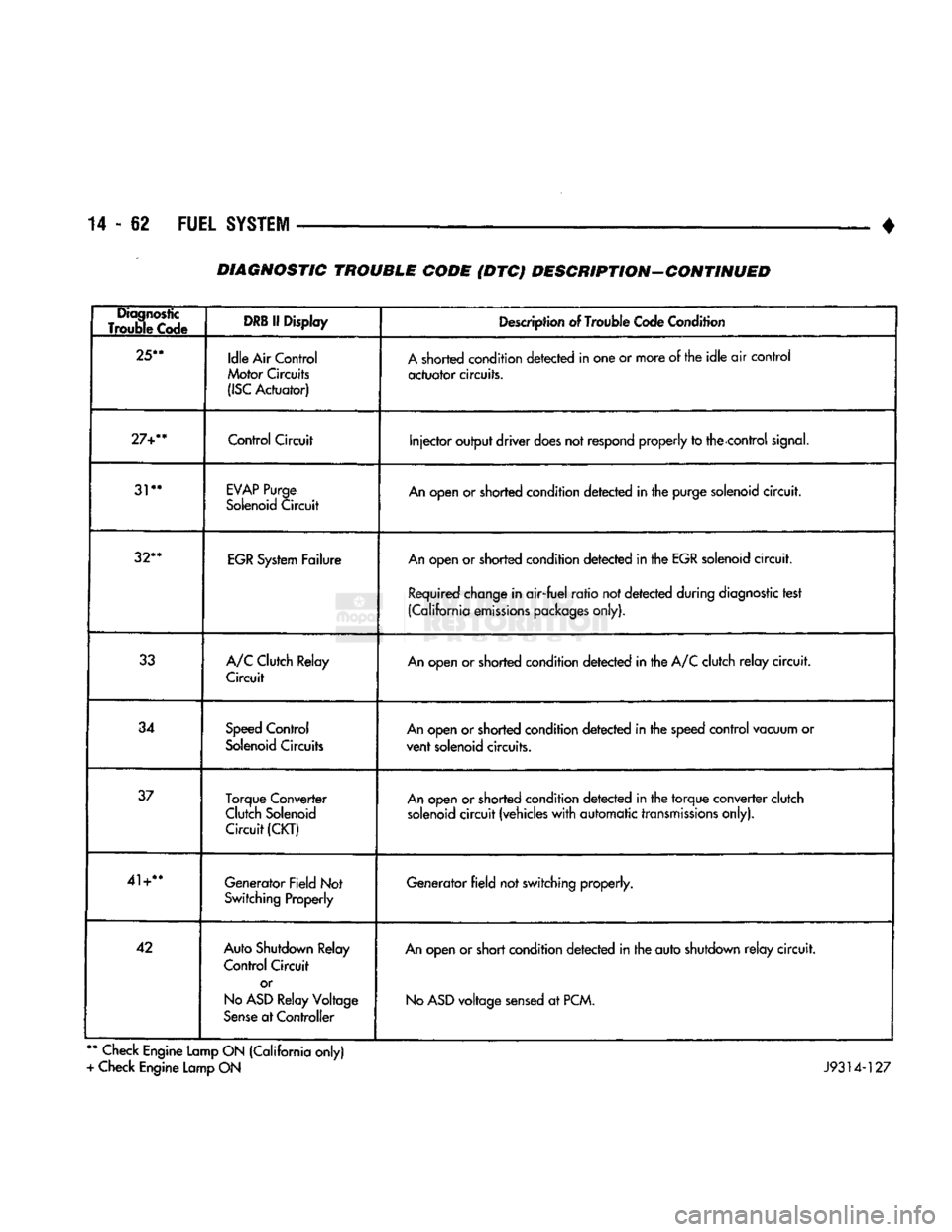
14-62 FUEL
SYSTEM
• DIAGNOSTIC TROUBLE CODE (DTC) DESCRIPTION-CONTINUED
Diagnostic
Trouble Code
DRB
If Display
Description of Trouble Code Condition
25**
Idle Air Control
Motor Circuits
(ISC
Actuator) A shorted condition detected in one or more of the idle air control
actuator circuits.
27+**
Control
Circuit
Injector output driver does not
respond
properly to the control
signal.
31**
EVAP
Purge
Solenoid Circuit An open or shorted condition detected in the purge solenoid circuit.
32**
EGR System Failure An open or shorted condition detected in the EGR solenoid circuit.
Required change in air-fuel ratio not detected during diagnostic test
(California emissions packages only).
33 A/C Clutch Relay
Circuit An open or shorted condition detected in the A/C clutch relay circuit.
34 Speed Control
Solenoid Circuits An open or shorted condition detected in the speed control vacuum or
vent solenoid circuits.
37 Torque Converter
Clutch Solenoid Circuit
(CKT)
An open or shorted condition detected in the torque converter clutch
solenoid circuit (vehicles with automatic transmissions only).
41+** Generator Field Not
Switching Properly Generator field not switching properly.
42 Auto Shutdown Relay
Control Circuit
or
No
ASD
Relay Voltage
Sense at Controller An open or short condition detected in the auto shutdown relay circuit.
No
ASD
voltage sensed at PCM.
**
Check Engine Lamp ON (California only)
+ Check Engine Lamp ON J9314-127
Page 882 of 1502
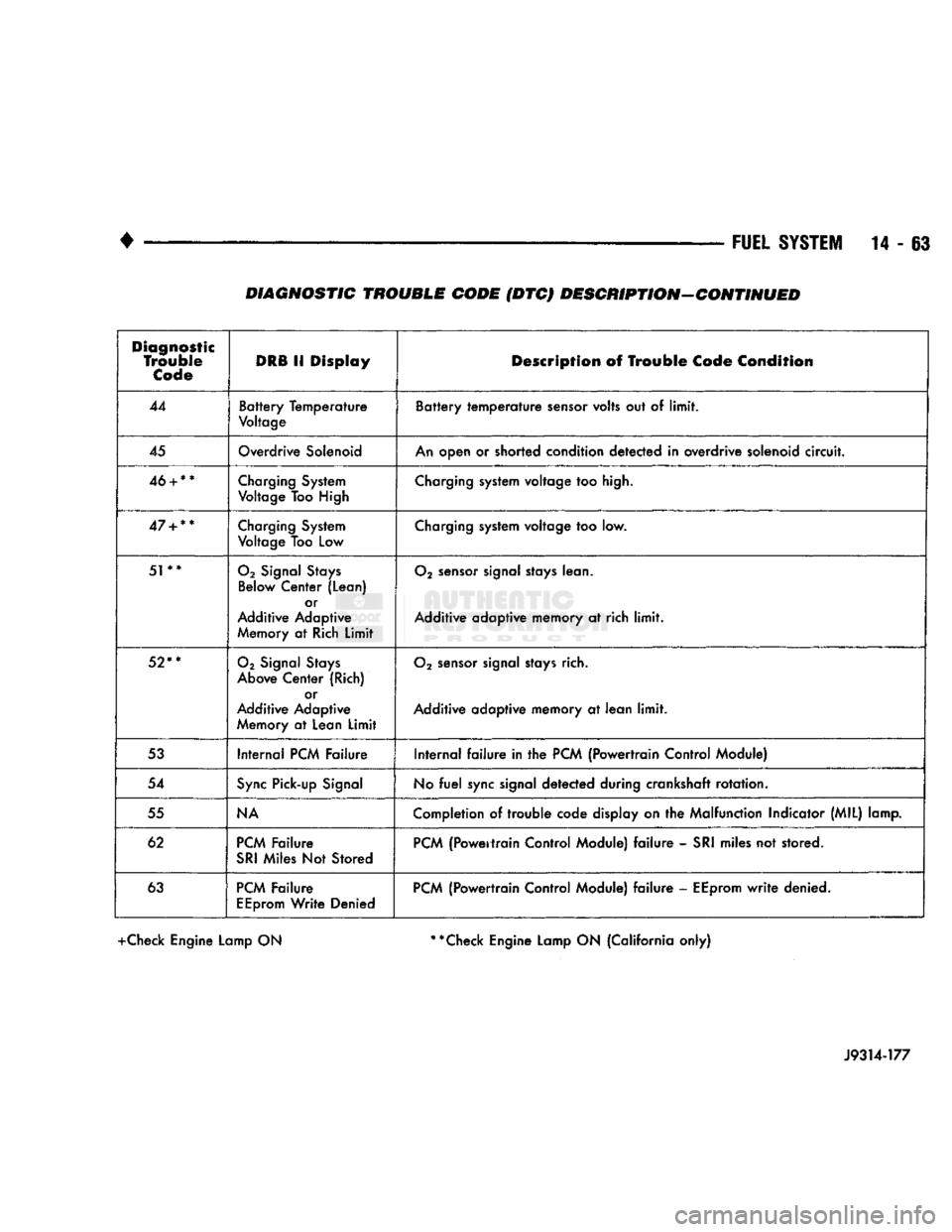
•
FUEL
SYSTEM
14 - 63 DIAGNOSTIC TROUBLE CODE (DTC) DESCRIPTION-CONTINUED
Diagnostic
Trouble
Code
DRB
11
Display
Description
of
Trouble
Code
Condition
44
Battery Temperature
Voltage
Battery temperature
sensor
volts
out of
limit.
45
Overdrive
Solenoid
An
open
or
shorted condition detected
in
overdrive solenoid
circuit.
46
+
**
Charging
System
Voltage
Too High
Charging
system voltage
too
high.
47
+
**
Charging
System
Voltage
Too
Low
Charging
system voltage
too low.
51**
02
Signal
Stays
Below
Center (Lean) or
Additive Adaptive
Memory
at
Rich
Limit
02
sensor
signal
stays
lean.
Additive adaptive memory
at rich
limit.
52**
02
Signal
Stays
Above
Center (Rich) or
Additive Adaptive
Memory
at
Lean
Limit
02
sensor
signal
stays
rich.
Additive adaptive memory
at
lean
limit.
53
Internal
PCM
Failure Internal
failure in the
PCM
{Powertrain Control Module)
54
Sync
Pick-up
Signal
No
fuel
sync
signal detected during crankshaft rotation.
55
NA
Completion
of trouble
code display
on the
Malfunction Indicator (MIL) lamp.
62
PCM
Failure
SRI
Miles
Not
Stored
PCM
(Powertrain Control Module)
failure -
SRI
miles
not
stored.
63
PCM
Failure
EEprom
Write Denied
PCM
(Powertrain Control Module)
failure -
EEprom
write
denied.
+Check Engine Lamp ON **Check Engine Lamp ON (California only)
J9314-177
Page 883 of 1502
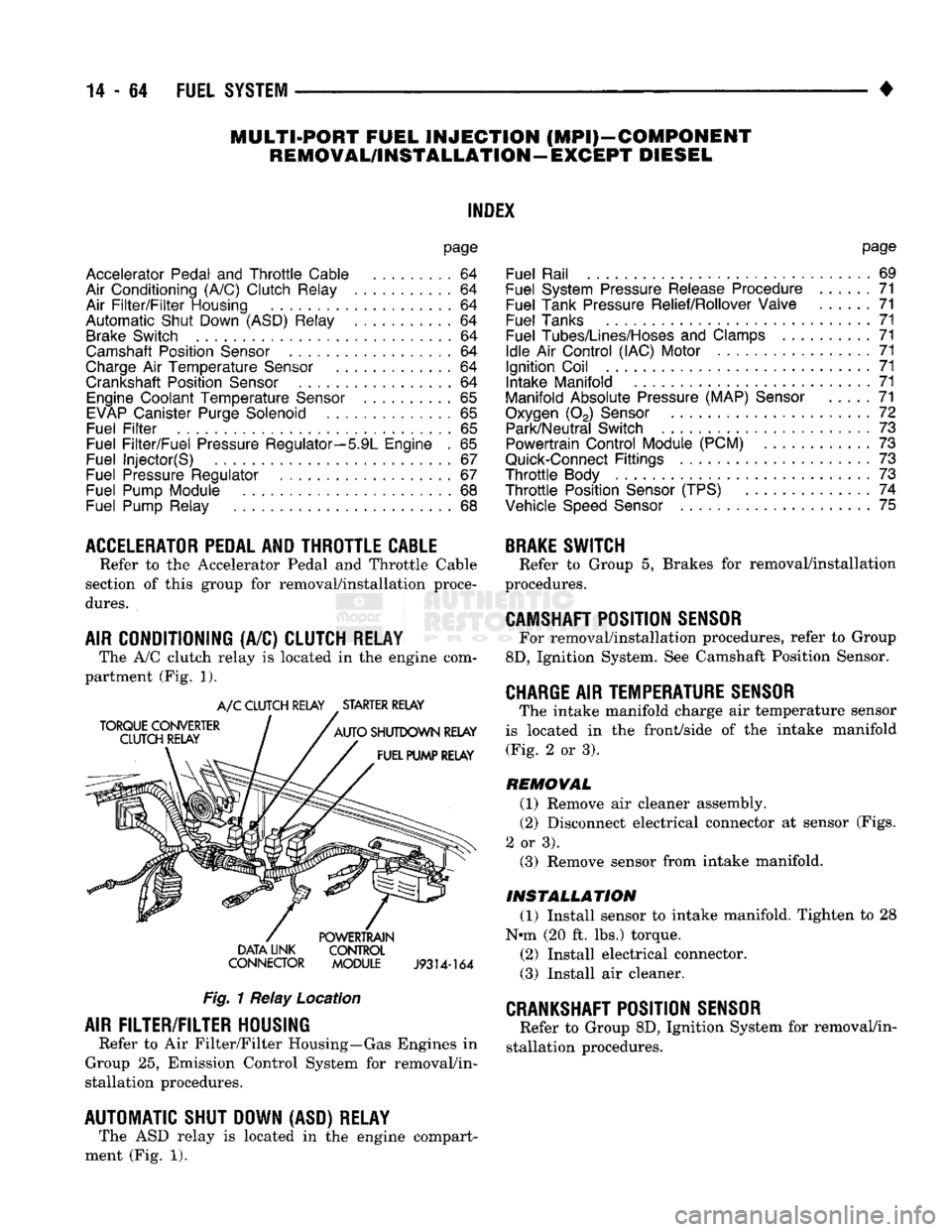
MULTI-PORT
FUEL
INJECTION
(MPI)-COMPONENT
REMOVAL/INSTALLATION
—EXCEPT DIESEL
INDEX
page
Accelerator Pedal
and Throttle
Cable
. 64
Air Conditioning (A/C) Clutch Relay
64
Air
Filter/Filter
Housing
64
Automatic Shut Down (ASD) Relay
. 64
Brake
Switch
64
Camshaft
Position
Sensor
..................
64
Charge
Air
Temperature
Sensor
64
Crankshaft Position
Sensor
64
Engine
Coolant Temperature
Sensor
65
EVAP
Canister Purge Solenoid
65
Fuel
Filter
65
Fuel Filter/Fuel Pressure Regulator—5.9L Engine
. 65
Fuel Injector(S)
67
Fuel Pressure Regulator
67
Fuel Pump Module
68
Fuel Pump Relay
68
ACCELERATOR
PEDAL
AND THROTTLE
CABLE
Refer
to
the
Accelerator Pedal
and
Throttle Cable
section
of
this group
for
removal/installation proce
dures.
AIR
CONDITIONING (A/C) CLUTCH RELAY The A/C clutch relay
is
located
in
the
engine com
partment (Fig.
1).
A/C CLUTCH RELAY STARTER RELAY
DATA LINK CONTROL
CONNECTOR MODULE
J9314-164
Fig.
1 Relay Location
AIR
FILTER/FILTER
HOUSING
Refer
to
Air Filter/Filter Housing—Gas Engines
in
Group
25,
Emission Control System
for
removal/in
stallation procedures.
AUTOMATIC SHUT DOWN (ASD) RELAY The ASD relay
is
located
in
the
engine compart
ment (Fig.
1).
page
Fuel Rail
69
Fuel System Pressure Release Procedure
......
71
Fuel Tank Pressure Relief/Rollover Valve
71
Fuel Tanks
71
Fuel
Tubes/Lines/Hoses
and
Clamps
71
Idle
Air
Control (IAC) Motor
71
Ignition Coil
71
Intake Manifold
71
Manifold Absolute Pressure (MAP)
Sensor
71
Oxygen
(02)
Sensor
72
Park/Neutral Switch
. 73
Powertrain Control Module (PCM)
73
Quick-Connect
Fittings
73
Throttle
Body
73
Throttle
Position
Sensor
(TPS)
......
74
Vehicle
Speed
Sensor
75
BRAKE
SWITCH
Refer
to
Group
5,
Brakes
for
removal/installation
procedures.
CAMSHAFT
POSITION
SENSOR
For removal/installation procedures, refer
to
Group
8D,
Ignition System. See Camshaft Position Sensor.
CHARGE
AIR
TEMPERATURE SENSOR
The intake manifold charge
air
temperature sensor
is located
in the
front/side
of
the
intake manifold (Fig.
2
or
3).
REMOVAL
(1) Remove
air
cleaner assembly.
(2) Disconnect electrical connector
at
sensor (Figs.
2
or
3). (3) Remove sensor from intake manifold.
INSTALLATION
(1) Install sensor
to
intake manifold. Tighten
to 28
Nnn (20
ft.
lbs.) torque.
(2) Install electrical connector.
(3) Install
air
cleaner.
CRANKSHAFT
POSITION
SENSOR
Refer
to
Group 8D, Ignition System
for
removal/in
stallation procedures.
Page 884 of 1502
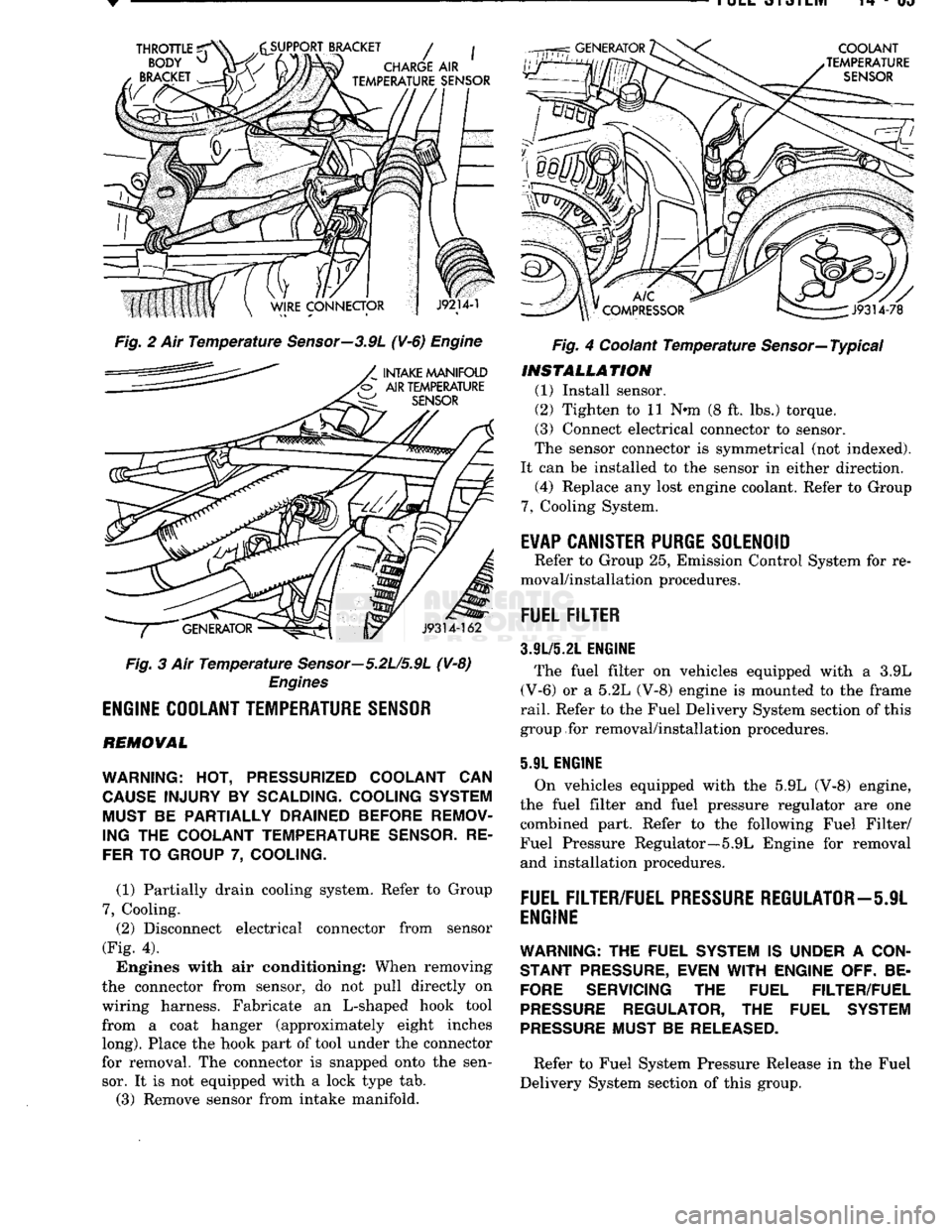
Fig. 2 Ait Temperature Sensor—3.9L (¥-6) Engine
Fig. 3 Air Temperature Sensor—5.2U5.9L (V-8)
Engines
ENGINE
COOLANT
TEMPERATURE
SENSOR
REMOVAL
WARNING:
HOT,
PRESSURIZED COOLANT
CAN
CAUSE
INJURY
BY
SCALDING- COOLING SYSTEM MUST
BE
PARTIALLY DRAINED BEFORE REMOV
ING
THE
COOLANT TEMPERATURE
SENSOR.
RE
FER
TO
GROUP
7,
COOLING.
(1) Partially drain cooling system. Refer to Group
7,
Cooling. (2) Disconnect electrical connector from sensor
(Fig. 4).
Engines with air conditioning: When removing
the connector from sensor, do not pull directly on
wiring harness. Fabricate an L-shaped hook tool from a coat hanger (approximately eight inches
long).
Place the hook part of tool under the connector
for removal. The connector is snapped onto the sen sor. It is not equipped with a lock type tab.
(3) Remove sensor from intake manifold. Fig. 4 Coolant Temperature Sensor—Typical
INSTALLATION
(1) Install sensor.
(2) Tighten to 11 Nnn (8 ft. lbs.) torque.
(3) Connect electrical connector to sensor.
The sensor connector is symmetrical (not indexed).
It can be installed to the sensor in either direction. (4) Replace any lost engine coolant. Refer to Group
7,
Cooling System.
E¥AP
CANISTER
PURGE
SOLENOID
Refer to Group 25, Emission Control System for re
moval/installation procedures.
FUEL
FILTER
3.9L/5.21.
ENGINE
The fuel filter on vehicles equipped with a 3.9L
(V-6) or a 5.2L (V-8) engine is mounted to the frame
rail.
Refer to the Fuel Delivery System section of this
group for removal/installation procedures.
5.91 ENGINE
On vehicles equipped with the 5.9L (V-8) engine,
the fuel filter and fuel pressure regulator are one combined part. Refer to the following Fuel Filter/
Fuel Pressure Regulator—5.9L Engine for removal and installation procedures.
FUEL
FILTER/FUEL
PRESSURE
REGULATOR—5JL
ENGINE
WARNING:
THE FUEL SYSTEM IS UNDER A
CON
STANT
PRESSURE,
EVEN
WITH
ENGINE OFF. BE
FORE
SERVICING THE FUEL FILTER/FUEL
PRESSURE
REGULATOR, THE FUEL SYSTEM
PRESSURE
MUST BE
RELEASED.
Refer to Fuel System Pressure Release in the Fuel
Delivery System section of this group.
Page 885 of 1502
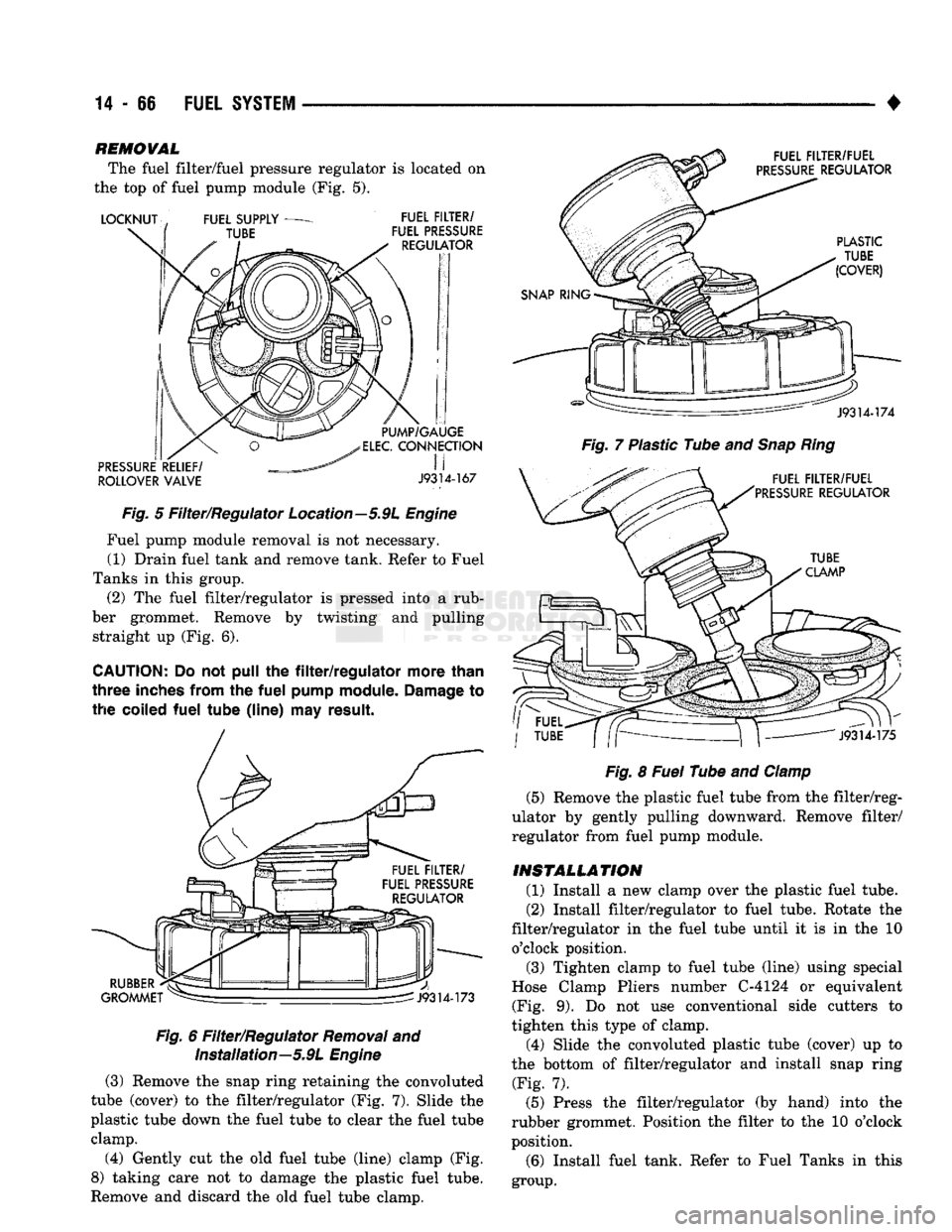
14
- 66
FUEL
SYSTEM
REMOVAL
The fuel filter/fuel pressure regulator is located on
the top of fuel pump module (Fig. 5).
ROLLOVER
VALVE
J9314-167
Fig.
5 Filter/Regulator Location—5.9L
Engine
Fuel pump module removal is not necessary. (1) Drain fuel tank and remove tank. Refer to Fuel
Tanks in this group. (2) The fuel filter/regulator is pressed into a rub
ber grommet. Remove by twisting and pulling straight up (Fig. 6).
CAUTION;
Do not pull the
filter/regulator
more
than
three
inches
from
the
fuel
pump
module.
Damage
to
the
coiled
fuel
tube
(line)
may
result.
Fig.
6 Filter/Regulator
Removal
and Installation—5.9L
Engine
(3) Remove the snap ring retaining the convoluted
tube (cover) to the filter/regulator (Fig. 7). Slide the
plastic tube down the fuel tube to clear the fuel tube clamp.
(4) Gently cut the old fuel tube (line) clamp (Fig.
8) taking care not to damage the plastic fuel tube.
Remove and discard the old fuel tube clamp.
Fig.
7 Plastic Tube and
Snap
Ring
Fig.
8
Fuel
Tube and
Clamp
(5) Remove the plastic fuel tube from the filter/reg
ulator by gently pulling downward. Remove filter/
regulator from fuel pump module.
INSTALLATION
(1) Install a new clamp over the plastic fuel tube.
(2) Install filter/regulator to fuel tube. Rotate the
filter/regulator in the fuel tube until it is in the 10 o'clock position. (3) Tighten clamp to fuel tube (line) using special
Hose Clamp Pliers number C-4124 or equivalent (Fig. 9). Do not use conventional side cutters to
tighten this type of clamp.
(4) Slide the convoluted plastic tube (cover) up to
the bottom of filter/regulator and install snap ring (Fig. 7).
(5) Press the filter/regulator (by hand) into the
rubber grommet. Position the filter to the 10 o'clock
position.
(6) Install fuel tank. Refer to Fuel Tanks in this
group.
Page 886 of 1502
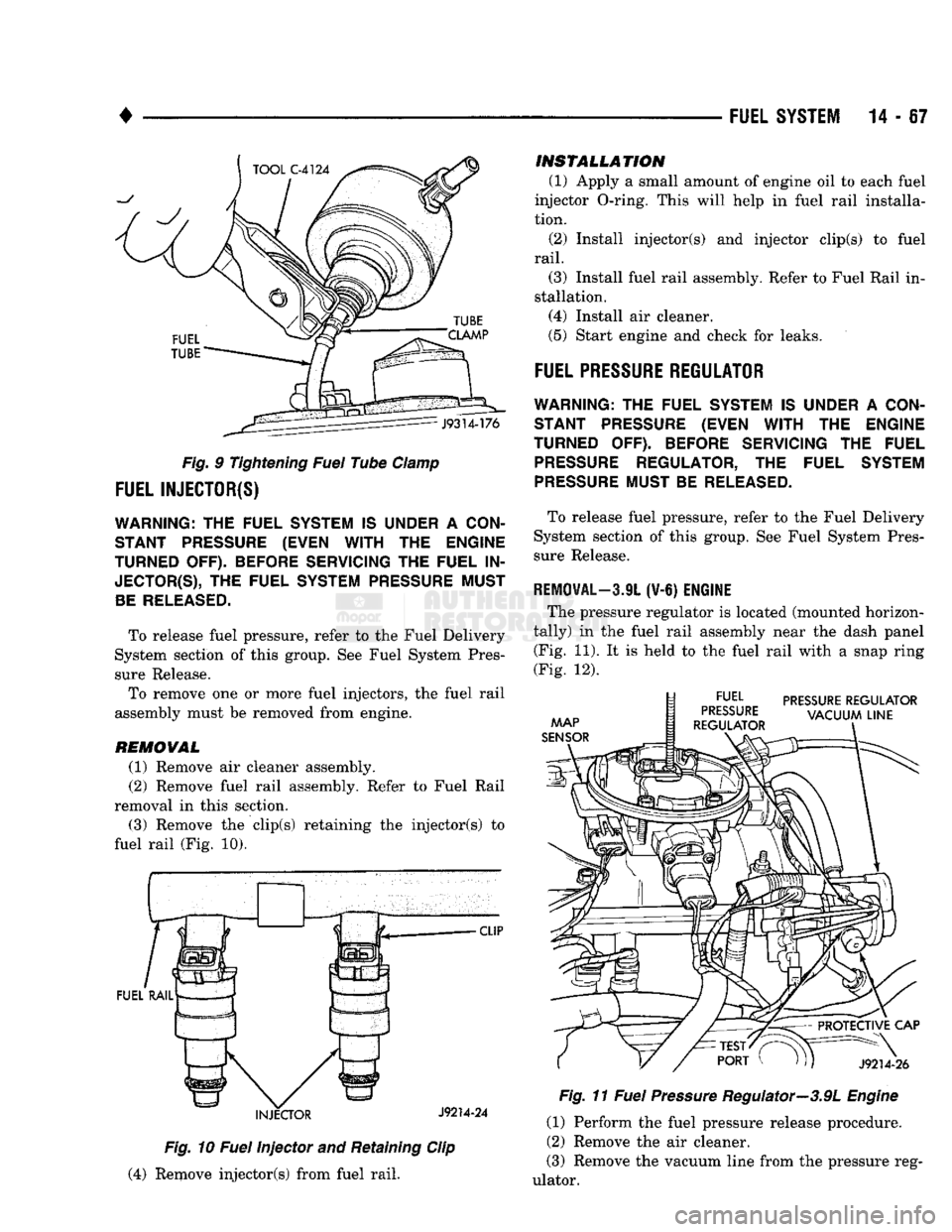
•
FUEL SYSTEM 14-67
Fig. 9 Tightening Fuel Tube Clamp
FUEL INJECTOR(S)
WARNING;
THE
FUEL
SYSTEM IS
UNDER
A
CON
STANT PRESSURE (EVEN
WITH THE
ENGINE
TURNED
OFF).
BEFORE SERVICING
THE
FUEL
IN
JECTOR^),
THE
FUEL
SYSTEM
PRESSURE MUST
BE
RELEASED.
To release fuel pressure, refer to the Fuel Delivery
System section of this group. See Fuel System Pres sure Release.
To remove one or more fuel injectors, the fuel rail
assembly must be removed from engine.
REMOVAL
(1) Remove air cleaner assembly. (2) Remove fuel rail assembly. Refer to Fuel Rail
removal in this section.
(3) Remove the clip(s) retaining the injector(s) to
fuel rail (Fig. 10).
CUP
Fig. 10 Fuel Injector and Retaining Clip
(4) Remove injector(s) from fuel rail.
INSTALLATION
(1) Apply a small amount of engine oil to each fuel
injector O-ring. This will help in fuel rail installa
tion.
(2) Install injector(s) and injector clip(s) to fuel
rail.
(3) Install fuel rail assembly. Refer to Fuel Rail in
stallation.
(4) Install air cleaner.
(5) Start engine and check for leaks.
FUEL PRESSURE REGULATOR
WARNING:
THE
FUEL SYSTEM
IS
UNDER
A
CON STANT PRESSURE (EVEN
WITH
THE
ENGINE
TURNED
OFF).
BEFORE SERVICING
THE
FUEL
PRESSURE
REGULATOR,
THE
FUEL SYSTEM
PRESSURE
MUST
BE
RELEASED.
To release fuel pressure, refer to the Fuel Delivery
System section of this group. See Fuel System Pres
sure Release.
REMOVAL—3JL
(V-6)
ENGINE
The pressure regulator is located (mounted horizon
tally) in the fuel rail assembly near the dash panel (Fig. 11). It is held to the fuel rail with a snap ring
(Fig. 12). Fig. 11 Fuel Pressure Regulator—3.9L Engine
(1) Perform the fuel pressure release procedure.
(2) Remove the air cleaner.
(3)
Remove the vacuum line from the pressure reg
ulator.
Page 887 of 1502
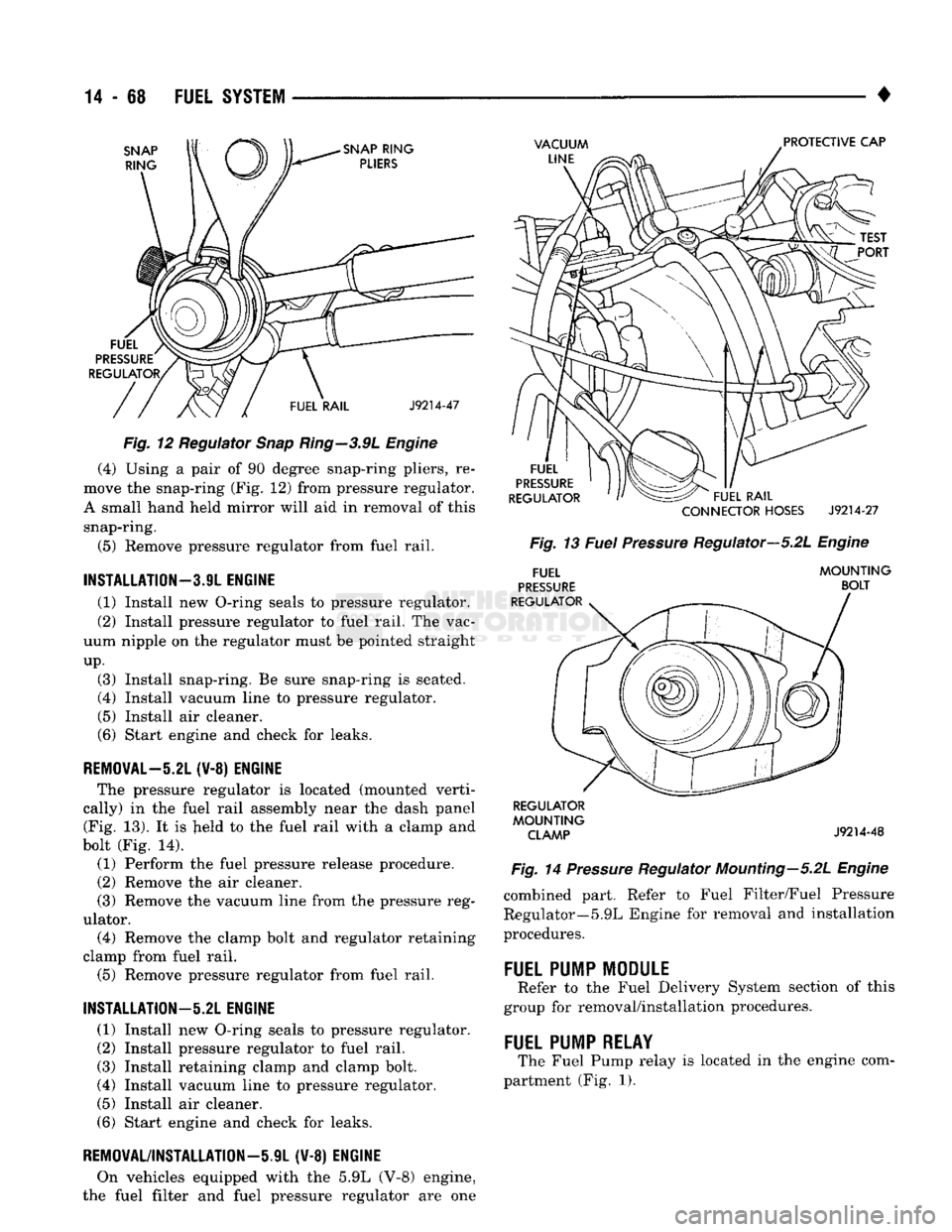
14
- 68
FUEL
SYSTEM
•
SNAP
RING
SNAP
RING
PLIERS
VACUUM
LINE
PROTECTIVE CAP
FUEL
PRESSURE
REGULATOR,
FUEL RAIL
J9214-47
Fig. 12 Regulator Snap Ring—3.9L Engine (4) Using a pair of 90 degree snap-ring pliers, re
move the snap-ring (Fig. 12) from pressure regulator.
A small hand held mirror will aid in removal of this snap-ring.
(5) Remove pressure regulator from fuel rail.
INSTALLATION—3.9L
ENGINE
(1) Install new O-ring seals to pressure regulator.
(2) Install pressure regulator to fuel rail. The vac
uum nipple on the regulator must be pointed straight
up.
(3) Install snap-ring. Be sure snap-ring is seated.
(4) Install vacuum line to pressure regulator.
(5) Install air cleaner.
(6) Start engine and check for leaks.
REMOVAL-5.21
(¥-8) ENGINE The pressure regulator is located (mounted verti
cally) in the fuel rail assembly near the dash panel (Fig. 13). It is Jield to the fuel rail with a clamp and
bolt (Fig. 14).
(1) Perform the fuel pressure release procedure.
(2) Remove the air cleaner.
(3) Remove the vacuum line from the pressure reg
ulator. (4) Remove the clamp bolt and regulator retaining
clamp from fuel rail.
(5) Remove pressure regulator from fuel rail.
INSTALLATION—5.2L
ENGINE
(1) Install new O-ring seals to pressure regulator.
(2) Install pressure regulator to fuel rail. (3) Install retaining clamp and clamp bolt.
(4) Install vacuum line to pressure regulator.
(5) Install air cleaner.
(6) Start engine and check for leaks.
REMOVAL/INSTALLATION—iJL (V-8) ENGINE
On vehicles equipped with the 5.9L (V-8) engine,
the fuel filter and fuel pressure regulator are one
FUEL
PRESSURE
REGULATOR FUEL RAIL
CONNECTOR
HOSES
J9214-27
Fig. 13 Fuel Pressure Regulator—5.2L Engine
FUEL
PRESSURE
REGULATOR MOUNTING
BOLT REGULATOR
MOUNTING CLAMP
J9214-48
Fig. 14 Pressure Regulator Mounting—5.2L Engine combined part. Refer to Fuel Filter/Fuel Pressure
Regulator—5.9L Engine for removal and installation
procedures.
FUEL
PUMP
MODULE
Refer to the Fuel Delivery System section of this
group for removal/installation procedures.
FUEL
PUMP
RELAY
The Fuel Pump relay is located in the engine com
partment (Fig. 1).
Page 888 of 1502
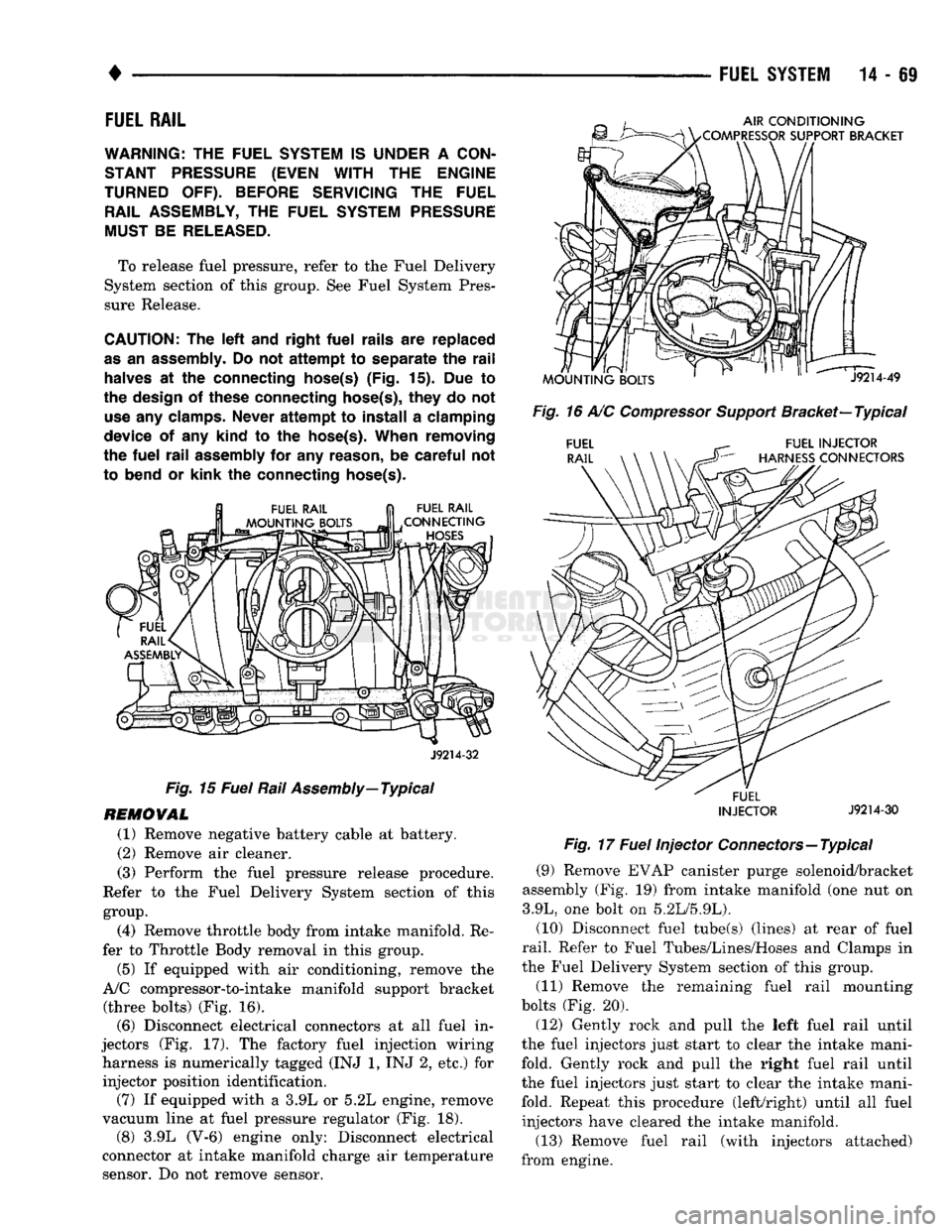
FUEL
RAIL
WARNING:
THE
FUEL SYSTEM
IS
UNDER
A
CON STANT PRESSURE (EVEN
WITH
THE
ENGINE
TURNED
OFF).
BEFORE SERVICING
THE
FUEL RAIL ASSEMBLY,
THE
FUEL SYSTEM PRESSURE
MUST
BE
RELEASED.
To release fuel pressure, refer to the Fuel Delivery
System section of this group. See Fuel System Pres
sure Release.
CAUTION:
The left and
right
fuel
rails
are
replaced
as
an
assembly.
Do not
attempt
to
separate
the
rail
halves
at the
connecting hose(s)
(Fig. 15). Due to
the design
of
these connecting hose(s),
they
do not
use
any
clamps. Never
attempt
to
install
a
clamping
device
of any
kind
to the
hose(s).
When
removing
the
fuel
rail
assembly
for any
reason,
be
careful
not
to bend
or
kink
the
connecting hose(s). FUEL RAIL
CONNECTING
HOSES
AIR
CONDITIONING
/COMPRESSOR
SUPPORT BRACKET
MOUNTING
BOLTS
' "
J9214-49
Fig.
16 A/C
Compressor
Support
Bracket—
Typical
FUEL RAIL FUEL INJECTOR
HARNESS
CONNECTORS
J9214-32
Fig.
15
Fuel
Rail
Assembly—
Typical
REMOVAL
(1) Remove negative battery cable at battery.
(2) Remove air cleaner.
(3) Perform the fuel pressure release procedure.
Refer to the Fuel Delivery System section of this group.
(4) Remove throttle body from intake manifold. Re
fer to Throttle Body removal in this group.
(5) If equipped with air conditioning, remove the
A/C compressor-to-intake manifold support bracket (three bolts) (Fig. 16). (6) Disconnect electrical connectors at all fuel in
jectors (Fig. 17). The factory fuel injection wiring harness is numerically tagged (INJ 1, INJ 2, etc.) for injector position identification. (7) If equipped with a 3.9L or 5.2L engine, remove
vacuum line at fuel pressure regulator (Fig. 18). (8) 3.9L (V-6) engine only: Disconnect electrical
connector at intake manifold charge air temperature sensor. Do not remove sensor. '
FUEL
INJECTOR
J9214-30
Fig.
17
Fuel
Injector Connectors—Typical
(9) Remove EVAP canister purge solenoid/bracket
assembly (Fig. 19) from intake manifold (one nut on
3.9L, one bolt on 5.2L/5.9L).
(10) Disconnect fuel tube(s) (lines) at rear of fuel
rail.
Refer to Fuel Tubes/Lines/Hoses and Clamps in
the Fuel Delivery System section of this group.
(11) Remove the remaining fuel rail mounting
bolts (Fig. 20).
(12) Gently rock and pull the left fuel rail until
the fuel injectors just start to clear the intake mani
fold. Gently rock and pull the right fuel rail until
the fuel injectors just start to clear the intake mani fold. Repeat this procedure (left/right) until all fuel injectors have cleared the intake manifold.
(13) Remove fuel rail (with injectors attached)
from engine.
Page 889 of 1502
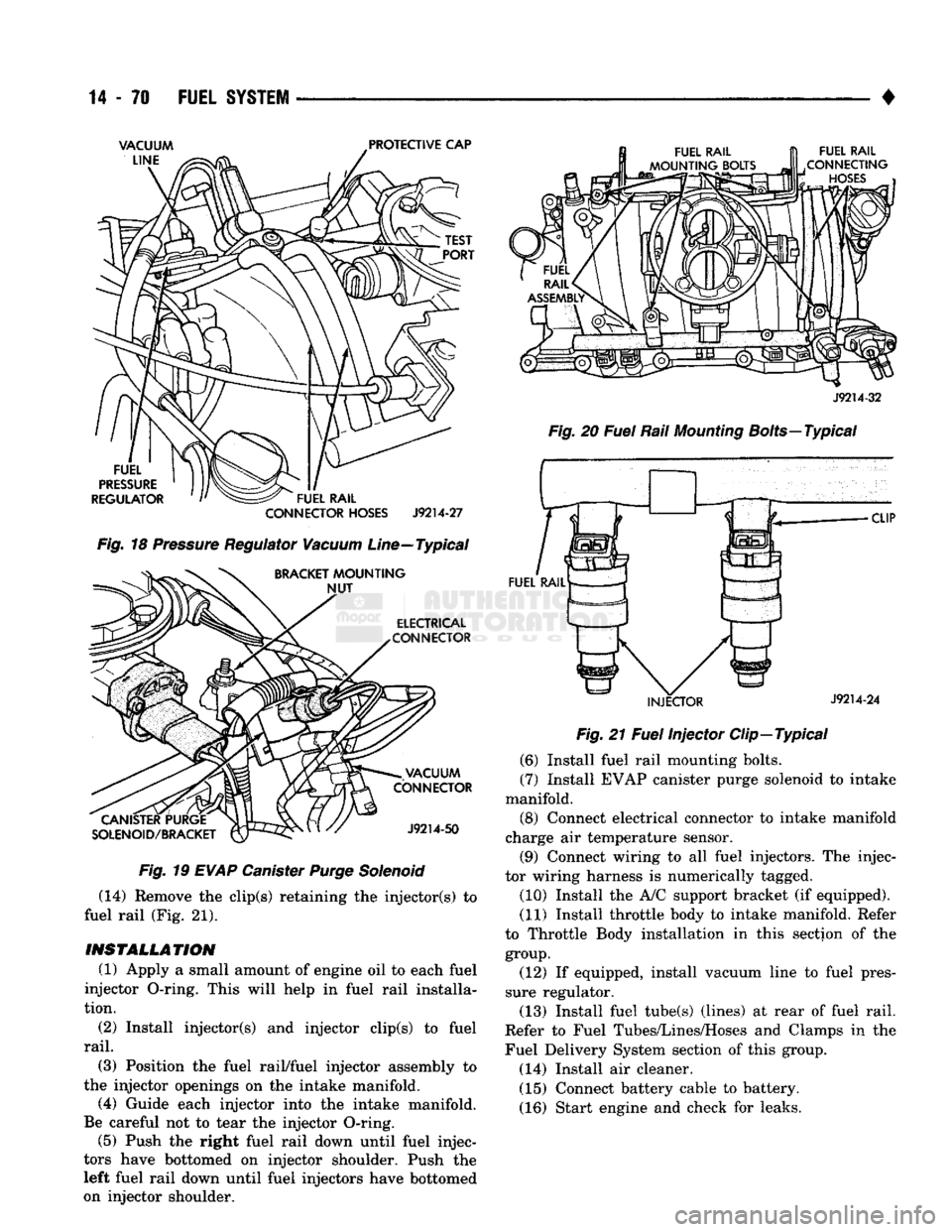
14
- 70
FUEL
SYSTEM
•
CANISTER PURGE
SOLENOID/BRACKET VACUUM
CONNECTOR
J9214-50
Fig.
19
EVAP
Canister
Purge
Solenoid
(14) Remove the clip(s) retaining the injector(s) to
fuel rail (Fig. 21).
INSTALLATION
(1) Apply a small amount of engine oil to each fuel
injector O-ring. This will help in fuel rail installa
tion.
(2) Install injector(s) and injector clip(s) to fuel
rail.
(3) Position the fuel rail/fuel injector assembly to
the injector openings on the intake manifold.
(4) Guide each injector into the intake manifold.
Be careful not to tear the injector O-ring. (5) Push the right fuel rail down until fuel injec
tors have bottomed on injector shoulder. Push the
left fuel rail down until fuel injectors have bottomed
on injector shoulder.
INJECTOR
J9214-24
Fig.
21
Fuel
Injector Clip—Typical
(6) Install fuel rail mounting bolts.
(7) Install EVAP canister purge solenoid to intake
manifold. (8) Connect electrical connector to intake manifold
charge air temperature sensor.
(9) Connect wiring to all fuel injectors. The injec
tor wiring harness is numerically tagged.
(10) Install the A/C support bracket (if equipped).
(11) Install throttle body to intake manifold. Refer
to Throttle Body installation in this section of the
group.
(12) If equipped, install vacuum line to fuel pres
sure regulator.
(13) Install fuel tube(s) (lines) at rear of fuel rail.
Refer to Fuel Tubes/Lines/Hoses and Clamps in the
Fuel Delivery System section of this group.
(14) Install air cleaner. (15) Connect battery cable to battery.
(16) Start engine and check for leaks.
Page 890 of 1502
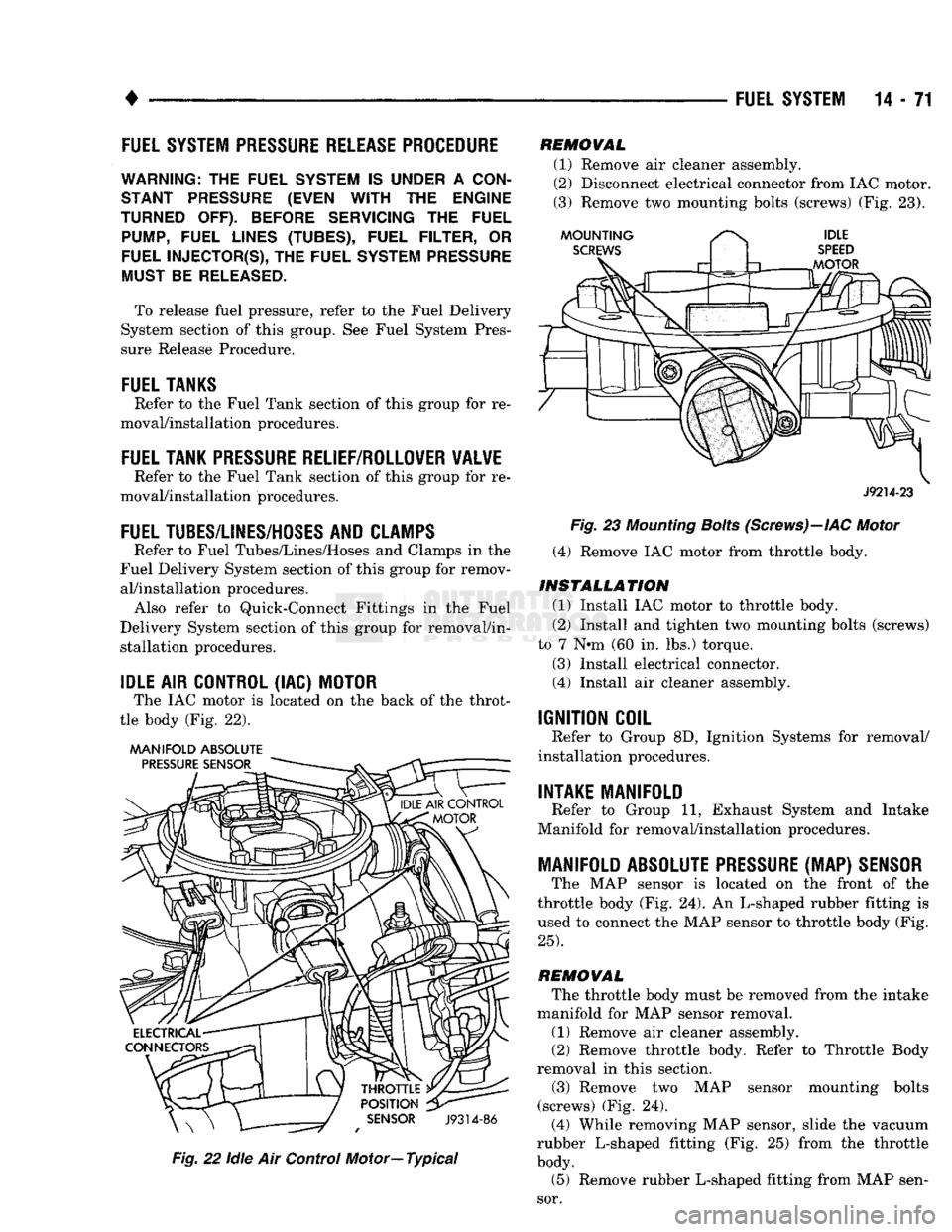
•
FUEL SYSTEM
14-71
FUEL SYSTEM PRESSURE RELEASE PROCEDURE
WARNING:
THE
FUEL
SYSTEM
IS
UNDER
A
CON
STANT
PRESSURE
(EVEN
WITH
THE
ENGINE
TURNED
OFF).
BEFORE
SERVICING
THE
FUEL
PUMP,
FUEL
LINES
(TUBES),
FUEL
FILTER,
OR
FUEL
INJECTOR(S),
THE
FUEL
SYSTEM
PRESSURE
MUST
BE
RELEASED.
To release fuel pressure, refer to the Fuel Delivery
System section of this group. See Fuel System Pres
sure Release Procedure.
FUEL TANKS
Refer to the Fuel Tank section of this group for re
moval/installation procedures.
FUEL TANK
PRESSURE
RELIEF/ROLLOVER VALVE
Refer to the Fuel Tank section of this group for re
moval/installation procedures.
FUEL
TUBES/LINES/HOSES
AND CLAMPS
Refer to Fuel Tubes/Lines/Hoses and Clamps in the
Fuel Delivery System section of this group for remov al/installation procedures. Also refer to Quick-Connect Fittings in the Fuel
Delivery System section of this group for removal/in
stallation procedures.
IDLE
AIR
CONTROL
(IAC)
MOTOR
The IAC motor is located on the back of the throt
tle body (Fig. 22).
MANIFOLD ABSOLUTE
Fig.
22
idle
Air Control Motor—Typical
REMOVAL
(1) Remove air cleaner assembly.
(2) Disconnect electrical connector from IAC motor.
(3) Remove two mounting bolts (screws) (Fig. 23).
J9214-23
Fig.
23
Mounting
Bolts
(Screws)—IAC
Motor
(4) Remove IAC motor from throttle body.
INSTALLATION
(1) Install IAC motor to throttle body.
(2) Install and tighten two mounting bolts (screws)
to 7 N»m (60 in. lbs.) torque.
(3) Install electrical connector.
(4) Install air cleaner assembly.
IGNITION COIL
Refer to Group 8D, Ignition Systems for removal/
installation procedures.
INTAKE MANIFOLD
Refer to Group 11, Exhaust System and Intake
Manifold for removal/installation procedures.
MANIFOLD ABSOLUTE
PRESSURE
(MAP)
SENSOR
The MAP sensor is located on the front of the
throttle body (Fig. 24). An L-shaped rubber fitting is
used to connect the MAP sensor to throttle body (Fig.
25).
REMOVAL
The throttle body must be removed from the intake
manifold for MAP sensor removal.
(1) Remove air cleaner assembly.
(2) Remove throttle body. Refer to Throttle Body
removal in this section.
(3) Remove two MAP sensor mounting bolts
(screws) (Fig. 24). (4) While removing MAP sensor, slide the vacuum
rubber L-shaped fitting (Fig. 25) from the throttle
body.
(5) Remove rubber L-shaped fitting from MAP sen
sor.